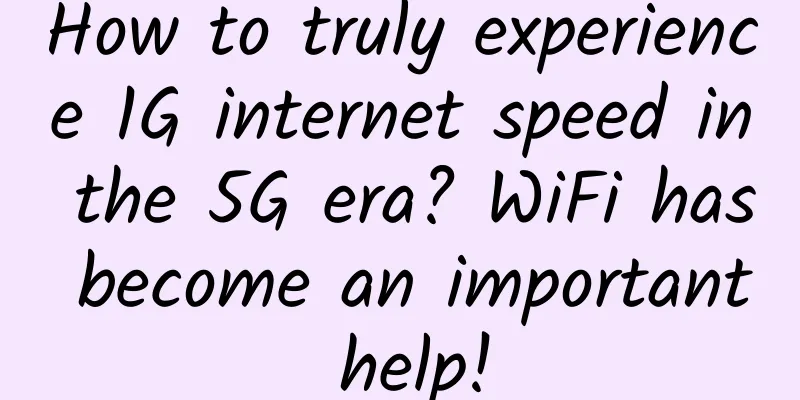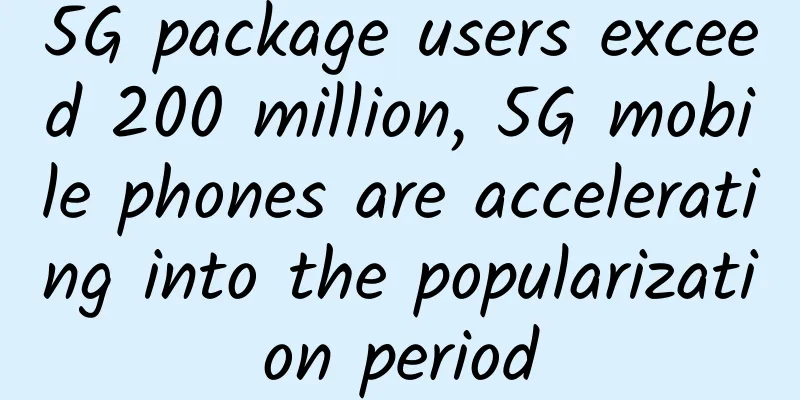How to truly experience 1G internet speed in the 5G era? WiFi has become an important help!

|
According to statistics, 20% of the sites in hotspot areas carry 80% of the entire network traffic, and the service rate of sites in hotspot areas is 6.5 times that of ordinary sites. The 5G standard already has technologies for hotspot high capacity, and when the connection demand in a certain area exceeds expectations, the most common way is to increase the capacity carrying capacity by building more dense base stations, but this simple and crude method has many problems. In recent years, the industry has been studying the technology of "traffic offloading" of mobile data, which may become a low-cost and effective way to solve the pain points in hotspot high capacity scenarios in the 5G era.
2019 is the starting year for 5G commercialization by mainstream operators around the world, and the continuous maturity of the industry chain has accelerated the implementation of 5G network deployment. However, since 3GPP has clearly postponed the freeze of R16, the initial 5G commercialization mainly focuses on enhanced mobile broadband (eMBB) scenarios. Based on the differences in scenarios, business needs and challenges, my country's 5G Standard Promotion Group IMT-2020 further defines eMBB in the "5G Concept White Paper" as two scenarios: continuous wide-area coverage and hotspot high-capacity. The main challenges for hotspot high-capacity include 1Gbps user experience rate, tens of Gbps peak rate and tens of Tbps/km2 traffic density. Ultra-high capacity poses a great challenge to the industry chain, and "traffic offloading" may be an effective way to increase network capacity at a low cost. Improving user experience through traffic offloading In the early stage of 5G commercialization, in order to quickly form a demonstration effect, various large-scale public events such as sports events, high-definition video live broadcasts of concerts, VR experience, etc. have become the best test sites for commercial demonstrations. Of course, these places will put extremely high pressure on the wireless network in a short period of time, and various means are needed to divert traffic. Similarly, shopping malls, airports and other places may also experience a surge in users during a certain period of time. When users find that although the mobile phone signal is full, the network speed is super slow, it means that the cellular network capacity has reached its limit, and the user experience is greatly reduced. According to Huawei's statistics, 20% of hotspot sites carry 80% of the entire network traffic, and the service rate of hotspot sites is 6.5 times that of ordinary sites. In the future 5G era, mobile terminals in these hotspots must maintain an experience rate of 1Gbps, and the capacity requirements in hotspots are higher. Ordinary people hear the "1Gbps bandwidth" promoted by 5G every day, but they may not be able to actually experience it. The 5G standard already has technologies for hotspot high capacity. When the connection demand in a certain area exceeds expectations, the most common way is to increase the capacity by building more dense base stations. However, this simple and crude method has a long construction period, and the cost of 5G base stations is also high. Whether it is economical to deploy more base stations is also a big problem. In recent years, the industry has been studying the technology of mobile data "traffic offloading", which may become a low-cost and effective way to solve the pain points in the hotspot high capacity scenario in the 5G era.
For example, it is necessary to increase capacity by deploying 5G base stations in sports stadiums, but on the one hand, the deployment of dense base stations to meet the excess access demand may make the marginal benefit less than the marginal cost. On the other hand, some areas only have high-capacity access demand during certain periods of time, and are relatively idle during other periods, so it is not economical. At this time, it is possible to consider making full use of existing or low-cost infrastructure as a carrier for cellular network traffic offloading, and enterprise or commercial WiFi may be one of the better ways. In daily work and life, many people turn on the WiFi switch of their mobile phones in places with WiFi signals such as offices and homes, and do not use cellular network traffic. To a certain extent, WiFi diverts traffic from the cellular network. However, this is only a spontaneous behavior of users, which can be said to be a passive behavior. It is not that operators actively provide automatic switching and diversion services to improve user experience. The traffic unloading work actively done by operators needs to be based on indicators such as the wireless network environment, the number of connected devices, and the device download rate. In order to achieve seamless switching between different access methods without users noticing, users can experience the same network rate instead of users passively choosing network switching. Under these requirements, if WiFi is to become an alternative solution for 5G traffic offloading after 5G is commercialized in the future, it needs to have a certain foundation in technology and business. Technical foundation: seamless integration, no-difference experience, and terminal support As an important alternative method for cellular network traffic offloading, the industry has been studying the technology and feasibility of WiFi offloading cellular networks for many years. For 5G network traffic offloading, in the future, WiFi needs to be seamlessly integrated with the cellular network, provide the same experience as the cellular network, and the terminals need to support the corresponding access methods. (1) Seamless integration of cellular networks and WiFi is supported by standards and industry In the past few years, there have been many studies and practices on mobile data traffic offloading based on WiFi. In 2013, IEEE/ACM Transactions on Networking published an article titled "Mobile Data Traffic Offloading: How Much Can WiFi Carry?" The results of the study on mobile data offloading solutions using WiFi networks showed that without introducing any delay, about 65% of mobile data can be offloaded, and because WiFi networks shorten transmission time, 55% of power can be saved. In the formulation of 5G standards, 3GPP has launched corresponding specifications to promote the integration of non-3GPP access technologies and 3GPP access technologies. In the completed 3GPP R15 specifications, the 5G core network supports access through 3GPP access networks and non-3GPP network access (such as WIFI). Non-3GPP networks access 5G networks through N3IWF (Non-3GPP InterWorking Function). In R16, which will be completed next year, the functions of WiFi and 5G integration will be further enhanced, including trusted WiFi support, traffic operations, switching, etc.
Earlier this year, the Next Generation Mobile Networks Alliance (NGMN) and the Wireless Broadband Alliance (WBA) released a report titled "Radio Access Network Convergence Report," which stated that the two major international organizations will work together to promote the convergence of 5G and WiFi, as well as the collaboration between the two wireless access networks. In addition to research institutions and standardization organizations, manufacturers have done a lot of work on the seamless integration of 5G and WiFi. For example, at the end of 2018, Huawei Honor launched LinkTurbo full-network aggregation technology in its new models, which can achieve simultaneous data transmission and reception of cellular and WiFi network links and intelligent seamless switching, providing key technical support for future 5G traffic offloading. (2) Technologies to provide a seamless experience between WiFi and 5G networks are already available When 5G coverage is not available or overloaded, WiFi is needed to offload traffic. It is very important for users to have the same experience of the two bearer modes. If WiFi fails to achieve the 5G experience rate, capacity, and service continuity after offloading traffic, user perception may be greatly reduced. With the progress of WiFi's corresponding standard technology, some technologies ensure that it can provide an experience similar to that of cellular networks. WiFi 6 and Passpoint are important technical accumulations. First of all, seamless switching between WiFi hotspots is the core to ensure business continuity. As we all know, when WiFi devices switch between different hotspots, they need to reconnect, authenticate and enter passwords. This process cannot guarantee that they can achieve the cellular network experience after unloading cellular traffic. In 2012, the WiFi Alliance, with the support of the Wireless Broadband Alliance (WBA), launched Passpoint technology, which can simplify WiFi network access. Users do not need to re-search and verify the network every time they connect to the network. Passpoint can automatically complete this process, allowing hotspot networks and mobile devices to connect seamlessly. At the same time, it can also provide the highest level of WPA2 security, ensuring that users are provided with an experience similar to that of cellular networks.
Secondly, the access method for offloading 5G traffic also needs to provide users with support for bandwidth, latency, and capacity similar to 5G. The new version of the WiFi 6 standard has been released, which is clearly aligned with the 5G enhanced mobile broadband (eMBB) scenario, and can provide an experience similar to 5G eMBB within its coverage area. For example, WiFi 6 introduces OFDMA technology from cellular networks, which increases the rate and reduces latency; it uses technology similar to cellular IoT to increase power spectrum density to improve coverage. With a maximum theoretical rate of 9.6Gbps and the ability to increase the average user throughput by at least 4 times in a dense user environment, WiFi 6 can provide a 5G-like experience after offloading 5G traffic. (3) Support of terminal equipment At the recent MWC, the release of new 5G devices has become the biggest highlight. As WiFi has become a standard feature of most smart terminals, chip manufacturers such as Qualcomm and MediaTek have begun to launch chips that support WiFi 6. With the improvement of 5G and WiFi 6 standards, terminals that support both 5G and WiFi 6 will quickly become popular. Passpoint has also been widely supported. Currently, a large number of iOS and Android phones support Passpoint, and more city Wi-Fi plans will carry Wi-Fi CERTIFIED Passpoint® certification. Therefore, it will be possible to offload traffic through WiFi in high-capacity 5G hotspot scenarios in the future. Business Basics: New Opportunities for Commercial WiFi Operators in the 5G Era The commercial practice of diverting traffic from cellular networks through WiFi has also been ongoing. As early as 2008, after the issuance of 3G licenses, an important practice of China Mobile in commercial use was to make up for the shortcomings of 3G networks by building WLAN hotspots. Due to the disadvantages of TD-SCDMA in technology, industrial chain, and cost, China Mobile used WiFi to divert traffic from 3G networks with poor experience, giving birth to a unique industrial chain of telecom-grade WLAN in just a few years. According to China Mobile's financial report data for the first half of 2013, during this period, China Mobile's wireless Internet service traffic increased by 129% year-on-year, of which WLAN absorbed about three-quarters of the total traffic, effectively playing the advantage of low-cost traffic carrying. However, at that time, the 3GPP standard did not have specifications for integration with WiFi, and Passpoint did not have a commercial basis, and could not provide a seamless switching experience. With the advancement of technology, traffic offloading can also provide a seamless switching experience. Recently, US telecom operator AT&T signed an agreement with Boingo, a well-known US commercial WiFi operator, to further expand cooperation in traffic offloading services. This cooperation is considered to be ready for the commercial use of 5G hotspots in high-capacity scenarios. The places where the two parties cooperate are mainly large airports, military bases and other places with Boingo Passpoint certified networks, so that AT&T devices can seamlessly roam safely between its cellular network and Boingo commercial WiFi, without users having to switch manually and without paying additional fees. AT&T believes that by 2022, driven by 4K video, drones, self-driving cars, VR/AR and other devices, 75% of its traffic will come from video applications. Therefore, it is necessary to cooperate with commercial WiFi manufacturers to lay out traffic offloading services in advance. Other operators such as Verizon and T-Mobile also have such cooperation intentions.
In the past decade, WiFi has been deployed in major places with concentrated traffic in various cities, such as stadiums, shopping malls, airports, high-speed rail stations, hotels, scenic spots, etc., and there are dedicated commercial WiFi operators to deploy and operate them. It can be seen that "traffic offloading" in the 5G era may bring new opportunities for a commercial WiFi operator to participate in 5G construction and operation, providing a starting point for it to expand innovative business. Just like Boingo in the United States, there are already many commercial WiFi operators in China, such as Maiwai Di and Baimi Life. These operators provide WiFi network connections and various derivative marketing and data analysis services for major commercial places. After years of efforts, commercial places in major cities in China have achieved large-scale WiFi coverage. However, due to the implementation of the national "speed increase and fee reduction" policy, telecom operators have significantly reduced 4G tariffs, which has put some pressure on commercial WiFi operators. In my opinion, after 5G is commercially available in the future, there will be a lot of room for cooperation between telecom operators and commercial WiFi operators in a large number of scenarios based on eMBB, one of which is the cooperation on traffic offloading. Commercial WiFi operators need to upgrade their infrastructure, including the deployment of APs that support WiFi 6 and Passpoint in the future. Just like the cooperation model between US operators and Boingo, commercial WiFi operators will open places where they have deployed WiFi hotspots and densely populated to telecom operators, and provide high-capacity traffic offloading support for 5G hotspots. Both parties can charge and share in a certain way. When commercial WiFi becomes an important carrier for traffic offloading in high-capacity areas of 5G hotspots, on the one hand, it will activate its existing network infrastructure, and on the other hand, it will open up new revenue channels. In addition, commercial WiFi operators will also have the opportunity to participate in the construction and operation of 5G and explore their business opportunities in 5G. 5G is not only about the complexity of its technology, but also about its greater inclusiveness. Considering the high investment in the future commercial use of 5G, if we can fully utilize and activate all kinds of existing infrastructure and achieve the effect of 5G commercial KPI, it can indeed save a lot of investment for the industry. Therefore, the exploration of traffic offloading services using WiFi is of great significance. |
<<: The content road for operators may not be smooth
Recommend
Thoroughly understand Session and Token
Hello everyone, I am amazing. When building a use...
HostDare: Los Angeles VPS with 10% off monthly payment and 30% off annual payment starting at $18/year, annual payment gives double memory + double traffic
HostDare released the latest promotion in LET, of...
RAKsmart adds Hong Kong large bandwidth and 20% discount promotion, US/Hong Kong/Japan cluster server 258 IP
RAKsmart has added a new Hong Kong high-bandwidth...
From telegraph to 5G, 7 changes in the 60-year history of mobile communications
The history of communication has been around for ...
Analysis on the development trend of indoor distribution system in the 5G era
With the development of mobile Internet communica...
DMIT: CN2 GIA in Hong Kong/CN2 GIA in Los Angeles Restocking from $100/year - Dual-core/2GB/40GB/2TB@2Gbps
DMIT.io has just restocked several special annual...
Shandong issues six standards for e-government cloud platform construction
Recently, Shandong issued six standards in the fi...
RAKsmart server flash sale starts from $30/month, 1-10Gbps unlimited traffic server starts from $149/month, VPS 50% off
This month, RAKsmart continues the previous activ...
What impact will the Internet of Things have on corporate business?
Nowadays, whether people like it or not, the Inte...
LiCloud: Hong Kong high bandwidth VPS annual payment starts from $17, Hong Kong dedicated server starts from $25.99/month, Huawei Cloud/BGP dual line
LiCloud.io has started a new September promotion,...
AWS launches 5G service, officially enters the mobile network market
Amazon Web Services (AWS) has launched the AWS Pr...
What you need to know about Wi-Fi 7
As Wi-Fi 7 continues to make waves in the technol...
80VPS: 350 yuan/month Korean server 2*E5-2450L/8GB/1TB/10M CN2/support upgrade
A few days ago, we shared the promotional VPS inf...
Huawei's Ding Yun: Expanding the Connectivity Business Landscape and Winning the Industry's Digital Blue Ocean
[Beijing, China, October 13, 2020] Today, the 6th...
The 10 hottest technology keywords in 2018, every move will change the future
The end of 2017 is accompanied by the arrival of ...









